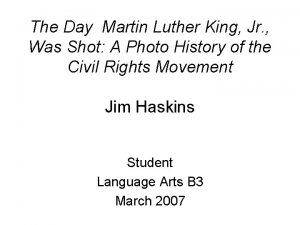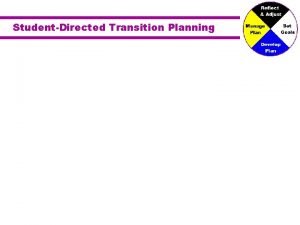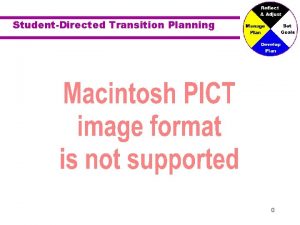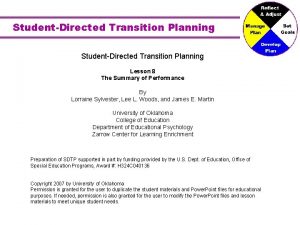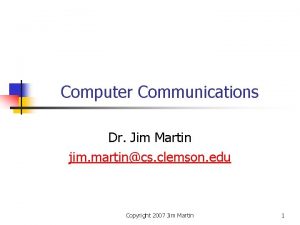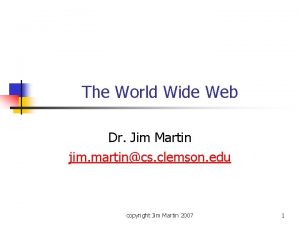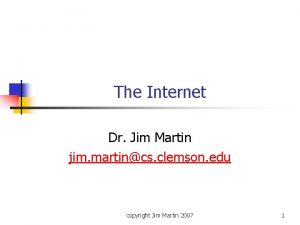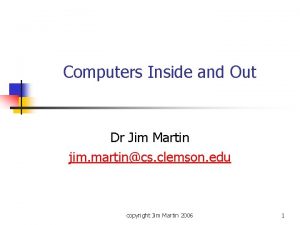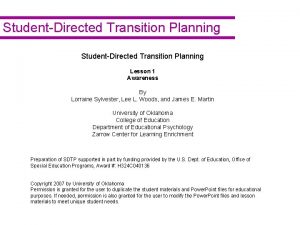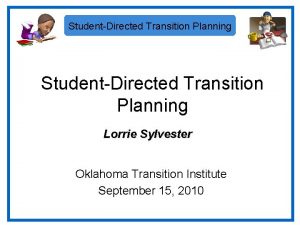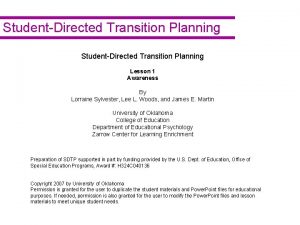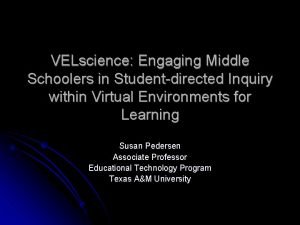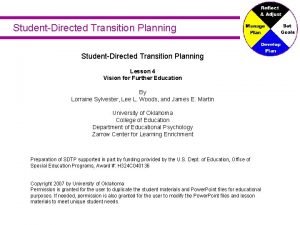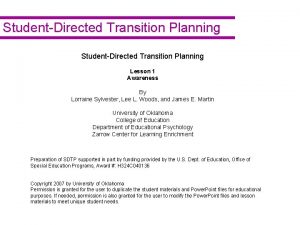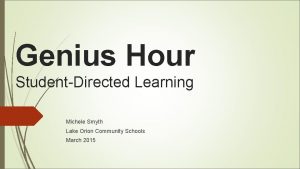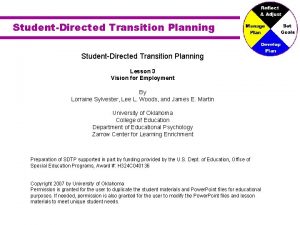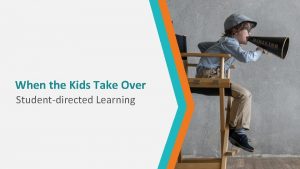The StudentDirected Summary of Performance SDSOP Jim Martin
































- Slides: 32

The Student-Directed Summary of Performance (SD-SOP) Jim Martin University of Oklahoma Jamie Van Dycke Oklahoma State University Marilyn D’Ottavio Albuquerque Public Schools Anita Eccard Oklahoma Department of Education

Presentation Agenda 1. Why Develop a Student-Directed Summary of Performance (SD-SOP)? 2. The Sections of the SD-SOP as adopted by Oklahoma 3. Applying the SD-SOP: A New Mexico Example 4. Incorporating the SD-SOP into Transition Education Practices

Why Develop a Student-Directed Summary of Performance (SD-SOP)?

Rationale • Transition mandates in IDEA 1997 and 2004 require transition planning that centers on students’ preferences and interests. • IDEA 2004 requires a Summary of Performance. • Students need to be the ones expressing their interests and preferences – especially in their IEP meetings. • Before students can express preferences and interests, they must develop crucial selfdetermination skills.

Self-Determination Field, Martin, Miller, Ward and Wehmeyer (1998) believe Self-Determination is: a combination of skills, knowledge, and beliefs that enable a person to engage in goal directed, self-regulated, autonomous behavior. An understanding of one’s strengths and limitations together with a belief in oneself as capable and effective are essential to self-determination. Field, S. , Martin, J. , Miller, R. , Ward, M. , & Wehmeyer, M. (1998). Self-determination for persons with disabilities: A position statement of the division on career development and transition. Career Development for Exceptional Individuals, 21(2), 113 -128.

Self-Determination Concepts • • Self-Awareness Self-Advocacy Decision Making Independent Performance Self-Evaluation Adjustment Self-Efficacy Martin, J. E. , & Marshall, L. H. (1995). Choice. Maker: A comprehensive self-determination transition program. Intervention in School and Clinic, 30(3), 147 -156.

Student Involvement in the IEP Process • Student involvement in the IEP process is an effective way to teach students valuable selfdetermination skills. • The Self-Directed IEP is an evidenced-based instructional package that teaches students how to become involved in their IEP meetings. Martin, J. E. , Marshall, L. H. , Maxson, L. , & Jerman, P. (1997). Self-Directed IEP. Longmont, CO: Sopris West.

Student Involvement in the IEP Transition Planning Process • Teaching students to be involved in their IEP meetings does not ensure that they will be involved in the development of their postschool goal/vision statement (Van Dycke, 2005), or that they actively participate in transition discussions at their IEP meetings (Martin et al. , 2006). • We need to make sure we are preparing students to develop their postschool goals. • The ideal way to do this is through the newly mandated Summary of Performance (SOP) with a student-directed focus (Martin, Van Dycke, D’Ottavio, & Nickerson, 2007).

The Sections of the SD-SOP As Adopted by Oklahoma

My Summary of Performance • My Postschool Goals for One Year After High School • My Perceptions of My Disability • The School’s Perspective on My Disability • School Produced Summary of My Academic and Functional Performance

Incorporating the SD-SOP Using the Student-Directed Transition Planning materials

Student-Directed Transition Planning • Purpose: To increase student involvement in transition planning discussions • U. S. Department of Education grant to develop lessons and research their effectiveness • Infuse best practices for reaching the largest number of students including those who are culturally and linguistically diverse

Identify the student’s post-school desired goals or visions.

Desired Goals • Employment, Further Education, Adult Living Goal Domains • Strengths • Needs • Vision • Obtain input from student, family, and teachers, and support staff • Uses Student-Directed Transition Planning

SDTP Available at www. education. ou. edu/zarrow click on transition education materials

Transition Planning

SDTP Lessons

Concepts and Terms for Transition Planning Image is the copyrighted property of Jupiter. Image and is used with permission under license


Review of Who’s Who in Transition Services Who did you find that was most helpful? Did you and your family think that the information you found would be helpful? 56

Transition Terminology Review Getting to Know the IEP Now that we have reviewed the transition concepts and vocabulary, let’s locate them on the transition pages of the IEP. 57

SDTP Lessons

Vision for Employment Strengths & Needs Gathering Input

What do you need from your family? What does your family need from you?

SDTP Lessons

Input Circle

Our Research Plan • Phase 1 • Does SD-TP increase student knowledge? • Does SD-TP increase student and family selfefficacy in the transition planning process? • Phase 2 • Does SD-TP increase student and family participation in transition planning discussions at IEP meetings?

New Concept Rather than just give SD-SOP when student’s leave: • Use Student-Directed SOP to frame transition plan and place for transition assessment information • Incorporates all transition assessment • Academic, vocational, social, living • Teach students to develop and present own SOP • Provides framework for exit meeting • Information flows into planning document and process


Our Research Plan • Phase 1 • Does SD-TP increase student knowledge? • Does SD-TP increase student and family selfefficacy in the transition planning process? • Phase 2 • Does SD-TP increase student and family participation in transition planning discussions at IEP meetings?

Applying the SD-SOP Concepts Example from Albuquerque, New Mexico

References Field, S. , Martin, J. , Miller, R. , Ward, M. , & Wehmeyer, M. (1998). Selfdetermination for persons with disabilities: A position statement of the division on career development and transition. Career Development for Exceptional Individuals, 21(2), 113 -128. Martin, J. E. , van Dycke, J. L. , Christensen, W. R. , Greene, B. A. , Gardner, J. E. , & Lovett, D. L. (2006). Increasing student participation in IEP meetings: Establishing the Self-Directed IEP as an evidenced-based practice. Exceptional Children, 72(3), 299. Martin, J. E. , & Marshall, L. H. (1995). Choice. Maker: A comprehensive selfdetermination transition program. Intervention in School and Clinic, 30(3), 147 -156. Martin, J. E. , Marshall, L. H. , Maxson, L. , & Jerman, P. (1997). Self-Directed IEP. Longmont, CO: Sopris West. Martin, J. E. , Van Dycke, J. , D’Ottavio, M. , & Nickerson, K. (2007). The student-directed summary of performance: Increasing student and family involvement in the transition planning process. Career Development for Exceptional Individuals, 30(1), 13 -26. Van Dycke, J. L. (2005). Determining the impact of Self-Directed IEP instruction on secondary IEP documents. Unpublished Dissertation.
 The day martin luther king jr was shot by jim haskins
The day martin luther king jr was shot by jim haskins Hát kết hợp bộ gõ cơ thể
Hát kết hợp bộ gõ cơ thể Lp html
Lp html Bổ thể
Bổ thể Tỉ lệ cơ thể trẻ em
Tỉ lệ cơ thể trẻ em Chó sói
Chó sói Glasgow thang điểm
Glasgow thang điểm Bài hát chúa yêu trần thế alleluia
Bài hát chúa yêu trần thế alleluia Môn thể thao bắt đầu bằng chữ f
Môn thể thao bắt đầu bằng chữ f Thế nào là hệ số cao nhất
Thế nào là hệ số cao nhất Các châu lục và đại dương trên thế giới
Các châu lục và đại dương trên thế giới Công thức tiính động năng
Công thức tiính động năng Trời xanh đây là của chúng ta thể thơ
Trời xanh đây là của chúng ta thể thơ Cách giải mật thư tọa độ
Cách giải mật thư tọa độ 101012 bằng
101012 bằng Phản ứng thế ankan
Phản ứng thế ankan Các châu lục và đại dương trên thế giới
Các châu lục và đại dương trên thế giới Thể thơ truyền thống
Thể thơ truyền thống Quá trình desamine hóa có thể tạo ra
Quá trình desamine hóa có thể tạo ra Một số thể thơ truyền thống
Một số thể thơ truyền thống Cái miệng nó xinh thế chỉ nói điều hay thôi
Cái miệng nó xinh thế chỉ nói điều hay thôi Vẽ hình chiếu vuông góc của vật thể sau
Vẽ hình chiếu vuông góc của vật thể sau Thế nào là sự mỏi cơ
Thế nào là sự mỏi cơ đặc điểm cơ thể của người tối cổ
đặc điểm cơ thể của người tối cổ Ví dụ giọng cùng tên
Ví dụ giọng cùng tên Vẽ hình chiếu đứng bằng cạnh của vật thể
Vẽ hình chiếu đứng bằng cạnh của vật thể Phối cảnh
Phối cảnh Thẻ vin
Thẻ vin đại từ thay thế
đại từ thay thế điện thế nghỉ
điện thế nghỉ Tư thế ngồi viết
Tư thế ngồi viết Diễn thế sinh thái là
Diễn thế sinh thái là Các loại đột biến cấu trúc nhiễm sắc thể
Các loại đột biến cấu trúc nhiễm sắc thể
